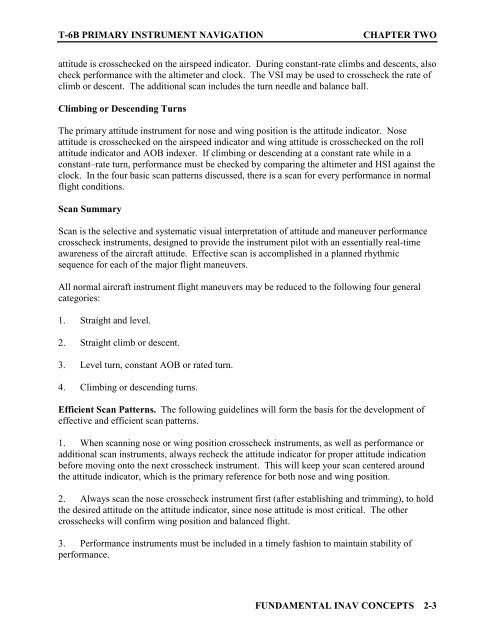Flight Training Instruction - Cnatra - U.S. Navy
Flight Training Instruction - Cnatra - U.S. Navy
Flight Training Instruction - Cnatra - U.S. Navy
Create successful ePaper yourself
Turn your PDF publications into a flip-book with our unique Google optimized e-Paper software.
T-6B PRIMARY INSTRUMENT NAVIGATION CHAPTER TWO<br />
attitude is crosschecked on the airspeed indicator. During constant-rate climbs and descents, also<br />
check performance with the altimeter and clock. The VSI may be used to crosscheck the rate of<br />
climb or descent. The additional scan includes the turn needle and balance ball.<br />
Climbing or Descending Turns<br />
The primary attitude instrument for nose and wing position is the attitude indicator. Nose<br />
attitude is crosschecked on the airspeed indicator and wing attitude is crosschecked on the roll<br />
attitude indicator and AOB indexer. If climbing or descending at a constant rate while in a<br />
constant–rate turn, performance must be checked by comparing the altimeter and HSI against the<br />
clock. In the four basic scan patterns discussed, there is a scan for every performance in normal<br />
flight conditions.<br />
Scan Summary<br />
Scan is the selective and systematic visual interpretation of attitude and maneuver performance<br />
crosscheck instruments, designed to provide the instrument pilot with an essentially real-time<br />
awareness of the aircraft attitude. Effective scan is accomplished in a planned rhythmic<br />
sequence for each of the major flight maneuvers.<br />
All normal aircraft instrument flight maneuvers may be reduced to the following four general<br />
categories:<br />
1. Straight and level.<br />
2. Straight climb or descent.<br />
3. Level turn, constant AOB or rated turn.<br />
4. Climbing or descending turns.<br />
Efficient Scan Patterns. The following guidelines will form the basis for the development of<br />
effective and efficient scan patterns.<br />
1. When scanning nose or wing position crosscheck instruments, as well as performance or<br />
additional scan instruments, always recheck the attitude indicator for proper attitude indication<br />
before moving onto the next crosscheck instrument. This will keep your scan centered around<br />
the attitude indicator, which is the primary reference for both nose and wing position.<br />
2. Always scan the nose crosscheck instrument first (after establishing and trimming), to hold<br />
the desired attitude on the attitude indicator, since nose attitude is most critical. The other<br />
crosschecks will confirm wing position and balanced flight.<br />
3. Performance instruments must be included in a timely fashion to maintain stability of<br />
performance.<br />
FUNDAMENTAL INAV CONCEPTS 2-3
















